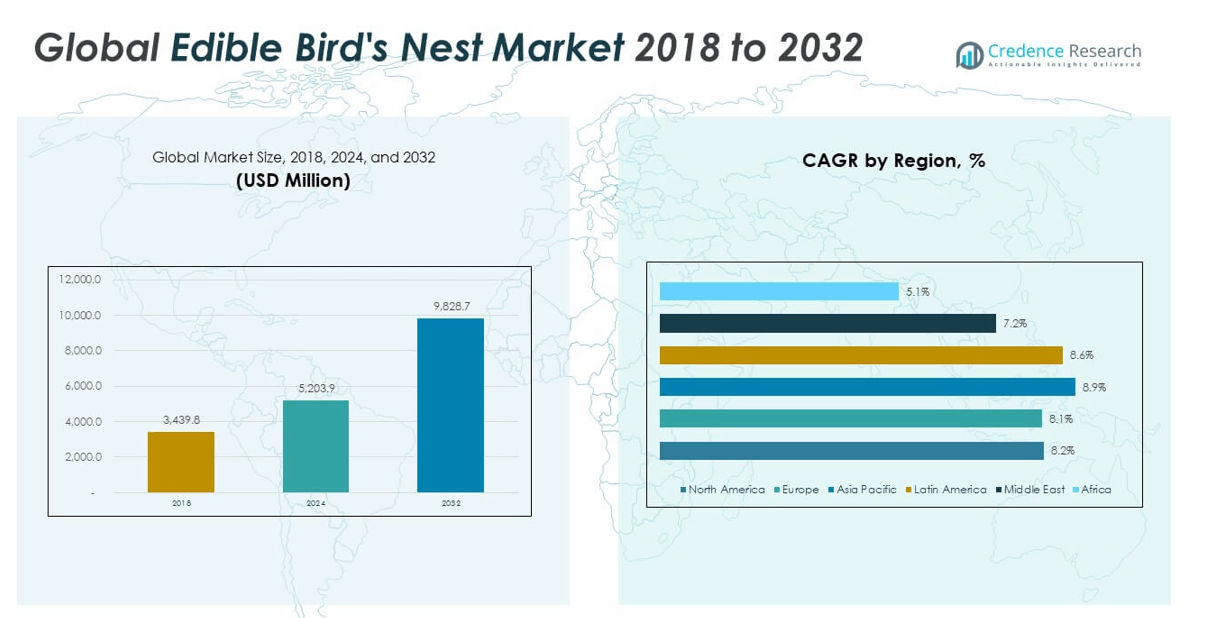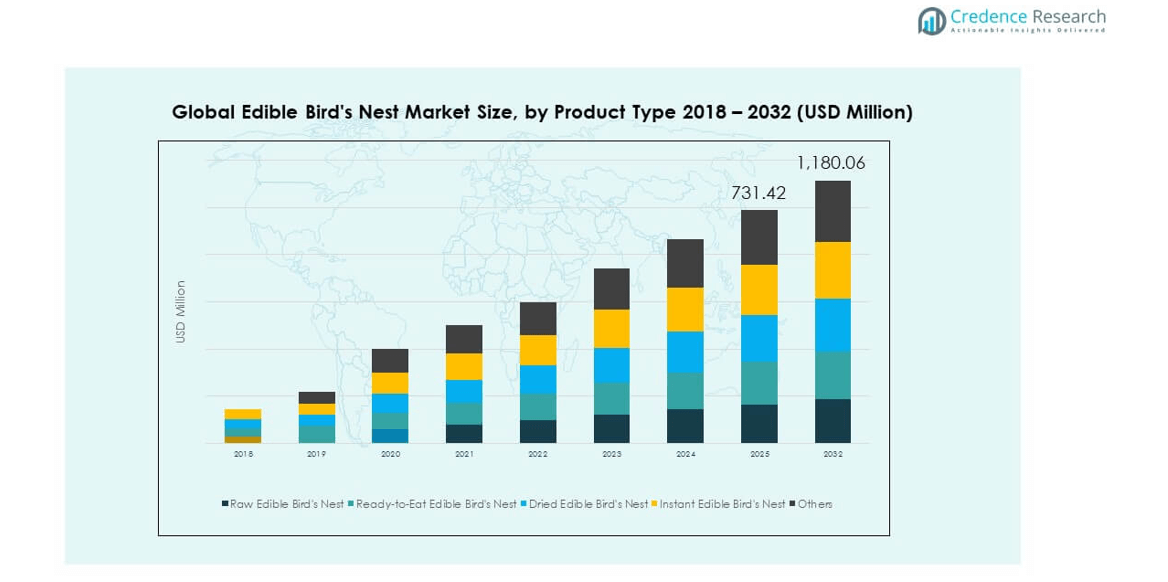CHAPTER NO. 1 : GENESIS OF THE MARKET
1.1 Market Prelude – Introduction & Scope
1.2 The Big Picture – Objectives & Vision
1.3 Strategic Edge – Unique Value Proposition
1.4 Stakeholder Compass – Key Beneficiaries
CHAPTER NO. 2 : EXECUTIVE LENS
2.1 Pulse of the Industry – Market Snapshot
2.2 Growth Arc – Revenue Projections (USD Million)
2.3. Premium Insights – Based on Primary Interviews
CHAPTER NO. 3 : EDIBLE BIRD’S NEST MARKET FORCES & INDUSTRY PULSE
3.1 Foundations of Change – Market Overview
3.2 Catalysts of Expansion – Key Market Drivers
3.2.1 Momentum Boosters – Growth Triggers
3.2.2 Innovation Fuel – Disruptive Technologies
3.3 Headwinds & Crosswinds – Market Restraints
3.3.1 Regulatory Tides – Compliance Challenges
3.3.2 Economic Frictions – Inflationary Pressures
3.4 Untapped Horizons – Growth Potential & Opportunities
3.5 Strategic Navigation – Industry Frameworks
3.5.1 Market Equilibrium – Porter’s Five Forces
3.5.2 Ecosystem Dynamics – Value Chain Analysis
3.5.3 Macro Forces – PESTEL Breakdown
3.6 Price Trend Analysis
3.6.1 Regional Price Trend
3.6.2 Price Trend by product
CHAPTER NO. 4 : KEY INVESTMENT EPICENTER
4.1 Regional Goldmines – High-Growth Geographies
4.2 Product Frontiers – Lucrative Product Categories
4.3 Application Sweet Spots – Emerging Demand Segments
CHAPTER NO. 5: REVENUE TRAJECTORY & WEALTH MAPPING
5.1 Momentum Metrics – Forecast & Growth Curves
5.2 Regional Revenue Footprint – Market Share Insights
5.3 Segmental Wealth Flow – Product Type, Color, Application, Formulation & Sales Channel Revenue
CHAPTER NO. 6 : TRADE & COMMERCE ANALYSIS
6.1. Import Analysis by Region
6.1.1. Global Edible Bird’s Nest Market Import Revenue By Region
6.2. Export Analysis by Region
6.2.1. Global Edible Bird’s Nest Market Export Revenue By Region
CHAPTER NO. 7 : COMPETITION ANALYSIS
7.1. Company Market Share Analysis
7.1.1. Global Edible Bird’s Nest Market: Company Market Share
7.2. Global Edible Bird’s Nest Market Company Revenue Market Share
7.3. Strategic Developments
7.3.1. Acquisitions & Mergers
7.3.2. New Product Launch
7.3.3. Regional Expansion
7.4. Competitive Dashboard
7.5. Company Assessment Metrics, 2024
CHAPTER NO. 8 : EDIBLE BIRD’S NEST MARKET – BY PRODUCT TYPE SEGMENT ANALYSIS
8.1. Edible Bird’s Nest Market Overview By Product Type Segment
8.1.1. Edible Bird’s Nest Market Revenue Share By Product Type
8.2. Raw Edible Bird’s Nest
8.3. Ready-to-Eat Edible Bird’s Nest
8.4. Dried Edible Bird’s Nest
8.5. Instant Edible Bird’s Nest
8.6. Others
CHAPTER NO. 9 : EDIBLE BIRD’S Nest MARKET – BY COLOR SEGMENT ANALYSIS
9.1. Edible Bird’s Nest Market Overview By Color Segment
9.1.1. Edible Bird’s Nest Market Revenue Share By Color
9.2. White Nest
9.3. Black Nest
9.4. Red Nest
9.5. Others
CHAPTER NO. 10 : EDIBLE BIRD’S NEST MARKET – BY APPLICATION SEGMENT ANALYSIS
10.1. Edible Bird’s Nest Market Overview By Application Segment
10.1.1. Edible Bird’s Nest Market Revenue Share By Application
10.2. Food and Beverage
10.3. Cosmetics
10.4. Pharmaceuticals
10.5. Nutraceuticals
10.6. Others
CHAPTER NO. 11 : EDIBLE BIRD’S NEST MARKET – BY FORMULATION TYPE SEGMENT ANALYSIS
11.1. Edible Bird’s Nest Market Overview By Formulation Type Segment
11.1.1. Edible Bird’s Nest Market Revenue Share By Formulation Type
11.2. Whole Nest
11.3. Processed Nest
11.4. Powdered Extract
11.5. Others
CHAPTER NO. 12 : EDIBLE BIRD’S NEST MARKET – BY SALES CHANNEL SEGMENT ANALYSIS
12.1. Edible Bird’s Nest Market Overview By Sales Channel Segment
12.1.1. Edible Bird’s Nest Market Revenue Share By Sales Channel
12.2. Supermarkets/Hypermarkets
12.3. Specialty Stores
12.4. Online Retail
12.5. Convenience Stores
12.6. Others
CHAPTER NO. 13 : EDIBLE BIRD’S NEST MARKET – REGIONAL ANALYSIS
13.1. Edible Bird’s Nest Market Overview by Region Segment
13.1.1. Global Edible Bird’s Nest Market Revenue Share By Region
13.1.2. Regions
13.1.3. Global Edible Bird’s Nest Market Revenue By Region
13.1.4. Product Type
13.1.5. Global Edible Bird’s Nest Market Revenue By Product Type
13.1.6. Application
13.1.7. Global Edible Bird’s Nest Market Revenue By Application
13.1.8. Color
13.1.9. Global Edible Bird’s Nest Market Revenue By Color
13.1.10. Formulation Type
13.1.12. Global Edible Bird’s Nest Market Revenue By Formulation Type
13.1.13. Sales Channel
13.1.14. Global Edible Bird’s Nest Market Revenue By Sales Channel
CHAPTER NO. 14 : NORTH AMERICA EDIBLE BIRD’S NEST MARKET – COUNTRY ANALYSIS
14.1. North America Edible Bird’s Nest Market Overview By Country Segment
14.1.1. North America Edible Bird’s Nest Market Revenue Share By Region
14.2. North America
14.2.1. North America Edible Bird’s Nest Market Revenue By Country
14.2.2. Product Type
14.2.3. North America Edible Bird’s Nest Market Revenue By Product Type
14.2.4. Application
14.2.5. North America Edible Bird’s Nest Market Revenue By Application
14.2.6. Color
14.2.7. North America Edible Bird’s Nest Market Revenue By Color
14.2.8. Formulation Type
14.2.9.North America Edible Bird’s Nest Market Revenue By Formulation Type
14.2.10. Sales Channel
14.2.11. North America Edible Bird’s Nest Market Revenue By Sales Channel
14.3. U.S.
14.4. Canada
14.5. Mexico
CHAPTER NO. 15 : EUROPE EDIBLE BIRD’S NEST MARKET – COUNTRY ANALYSIS
15.1. Europe Edible Bird’s Nest Market Overview By Country Segment
15.1.1. Europe Edible Bird’s Nest Market Revenue Share By Region
15.2. Europe
15.2.1. Europe Edible Bird’s Nest Market Revenue By Country
15.2.2. Product Type
15.2.3. Europe Edible Bird’s Nest Market Revenue By Product Type
15.2.4. Application
15.2.5. Europe Edible Bird’s Nest Market Revenue By Application
15.2.6. Color
15.2.7. Europe Edible Bird’s Nest Market Revenue By Color
15.2.8. Formulation Type
15.2.9. Europe Edible Bird’s Nest Market Revenue By Formulation Type
15.2.10. Sales Channel
15.2.11. Europe Edible Bird’s Nest Market Revenue By Sales Channel
15.3. UK
15.4. France
15.5. Germany
15.6. Italy
15.7. Spain
15.8. Russia
15.9. Rest of Europe
CHAPTER NO. 16 : ASIA PACIFIC EDIBLE BIRD’S NEST MARKET – COUNTRY ANALYSIS
16.1. Asia Pacific Edible Bird’s Nest Market Overview By Country Segment
16.1.1.Asia Pacific Edible Bird’s Nest Market Revenue Share By Region
16.2. Asia Pacific
16.2.1. Asia Pacific Edible Bird’s Nest Market Revenue By Country
16.2.2. Product Type
16.2.3. Asia Pacific Edible Bird’s Nest Market Revenue By Product Type
16.2.4. Application
16.2.5. Asia Pacific Edible Bird’s Nest Market Revenue By Application
16.2.6. Color
16.2.7.Asia Pacific Edible Bird’s Nest Market Revenue By Color
16.2.8. Formulation Type
16.2.9. Asia Pacific Edible Bird’s Nest Market Revenue By Formulation Type
16.2.10. Sales Channel
16.2.11. Asia Pacific Edible Bird’s Nest Market Revenue By Sales Channel
16.3. China
16.4. Japan
16.5. South Korea
16.6. India
16.7. Australia
16.8. Southeast Asia
16.9. Rest of Asia Pacific
CHAPTER NO. 17 : LATIN AMERICA EDIBLE BIRD’S NEST MARKET – COUNTRY ANALYSIS
17.1. Latin America Edible Bird’s Nest Market Overview By Country Segment
17.1.1. Latin America Edible Bird’s Nest Market Revenue Share By Region
17.2. Latin America
17.2.1. Latin America Edible Bird’s Nest Market Revenue By Country
17.2.2. Product Type
17.2.3. Latin America Edible Bird’s Nest Market Revenue By Product Type
17.2.4. Application
17.2.5. Latin America Edible Bird’s Nest Market Revenue By Application
17.2.6. Color
17.2.7. Latin America Edible Bird’s Nest Market Revenue By Color
17.2.8. Formulation Type
17.2.9. Latin America Edible Bird’s Nest Market Revenue By Formulation Type
17.2.10. Sales Channel
17.2.11. Latin America Edible Bird’s Nest Market Revenue By Sales Channel
17.3. Brazil
17.4. Argentina
17.5. Rest of Latin America
CHAPTER NO. 18 : MIDDLE EAST EDIBLE BIRD’S NEST MARKET – COUNTRY ANALYSIS
18.1. Middle East Edible Bird’s Nest Market Overview By Country Segment
18.1.1.Middle East Edible Bird’s Nest Market Revenue Share By Region
18.2. Middle East
18.2.1. Middle East Edible Bird’s Nest Market Revenue By Country
18.2.2. Product Type
18.2.3. Middle East Edible Bird’s Nest Market Revenue By Product Type
18.2.4. Application
18.2.5. Middle East Edible Bird’s Nest Market Revenue By Application
18.2.6. Color
18.2.7.Middle East Edible Bird’s Nest Market Revenue By Color
18.2.8. Formulation Type
18.2.9. Middle East Edible Bird’s Nest Market Revenue By Formulation Type
18.2.10. Sales Channel
18.2.11. Middle East Edible Bird’s Nest Market Revenue By Sales Channel
18.3. GCC Countries
18.4. Israel
18.5. Turkey
18.6. Rest of Middle East
CHAPTER NO. 19 : AFRICA EDIBLE BIRD’S NEST MARKET – COUNTRY ANALYSIS
19.1. Africa Edible Bird’s Nest Market Overview By Country Segment
19.1.1. Africa Edible Bird’s Nest Market Revenue Share By Region
19.2. Africa
19.2.1. Africa Edible Bird’s Nest Market Revenue By Country
19.2.2. Product Type
19.2.3. Africa Edible Bird’s Nest Market Revenue By Product Type
19.2.4. Application
19.2.5. Africa Edible Bird’s Nest Market Revenue By Application
19.2.6. Color
19.2.7. Africa Edible Bird’s Nest Market Revenue By Color
19.2.8. Formulation Type
19.2.9. Africa Edible Bird’s Nest Market Revenue By Formulation Type
19.2.10. Sales Channel
19.2.11. Africa Edible Bird’s Nest Market Revenue By Sales Channel
19.3. South Africa
19.4. Egypt
19.5. Rest of Africa
CHAPTER NO. 20 : COMPANY PROFILES
20.1. Golden Nest
20.1.1. Company Overview
20.1.2. Product Portfolio
20.1.3. Financial Overview
20.1.4.Recent Developments
20.1.5. Growth Strategy
20.1.6. SWOT Analysis
20.2. Dragon Brand Bird’s Nest
20.3. Lo Hong Ka
20.4. Yen Viet
20.5. City of Swallows
20.6. Kim Hing Food Industries
20.7. Swiftlet Eco Park
20.8. PT. Tong Heng Invesco
20.9. Fujian Xiamen Oriental Bird’s Nest Co., Ltd.
20.10. PT. Esta Indonesia
20.11. Gaharu Bird’s Nest
20.12. PT. Royal Bird’s Nest
20.13. Yen Viet Joint Stock Company
20.14. PT. Borneo Bird’s Nest
20.15. PT. Jangkar Swallow





